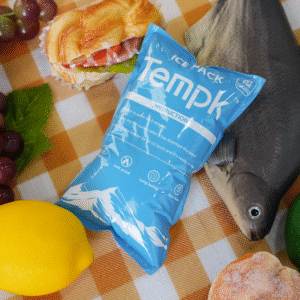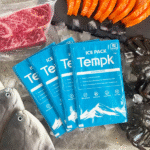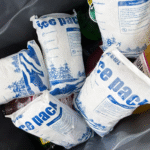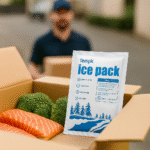Pacotes de gelo seco para envio: How to Safely Transport Temperature-Sensitive Goods
Shipping temperature-sensitive goods requires a reliable cooling method to preserve product integrity. Dry ice packs have long been the solution to maintain frozen or chilled temperatures during transit. Seja enviando comida, produtos farmacêuticos, ou outros bens perecíveis, dry ice plays a crucial role in ensuring that products stay at the correct temperature. Este guia explora os benefícios, uso, and safety considerations when shipping with dry ice, along with innovations in the field.
-
Por que são dry ice packs necessary for shipping bens perecíveis?
-
How do dry ice packs keep goods at the ideal temperature?
-
What best practices should you follow for safe and effective dry ice shipping?
-
What safety measures must be considered when using dry ice?
Why Are Dry Ice Packs Necessary for Shipping?
Dry ice is essential for keeping perishable goods at the desired temperature. Gelo seco é dióxido de carbono sólido (Co₂), que sublima diretamente de um sólido para um gás a -78,5°C (-109.3°F). This ultra-low temperature makes dry ice ideal for maintaining frozen conditions during shipments, especially for products like vaccines, frutos do mar, e amostras biológicas.
Benefits of Dry Ice for Shipping:
-
Controle de temperatura: Dry ice maintains freezing conditions during transit.
-
Sem resíduos: Ao contrário do gelo regular, Gelo seco não derrete na água, which prevents moisture damage to products.
-
Duradouro: O gelo seco dura mais do que o gelo tradicional, making it perfect for extended shipping durations.
| Característica | Descrição | Por que isso importa |
|---|---|---|
| Faixa de temperatura | -78.5°C | Keeps items frozen or chilled |
| Taxa de sublimação | 5-10 libras cada 24 horas | Determines the amount of dry ice needed |
| Regulamentos de envio | Subject to DOT and IATA rules | Ensures compliance to avoid delays |
Exemplo:
A pharmaceutical company reported that using dry ice packs helped their medical supplies maintain the required temperature for over 48 horas, reduzindo a deterioração por 15%.
How Do Dry Ice Packs Work to Keep Goods at the Right Temperature?
Dry ice works by sublimating and absorbing heat. This cooling effect keeps temperature-sensitive items, like vaccines or frozen foods, at the desired temperature during shipping. O gelo seco sublima (se transforma em gás), which continuously lowers the temperature inside the container, preventing the goods from warming up.
Principais recursos dos pacotes de gelo seco:
-
Sublimação: Dry ice sublimates steadily at a rate of 5-10 libras a cada 24 horas.
-
No Water: À medida que o gelo seco sublima, it turns into gas, leaving no water to cause leaks or spoilage.
-
Resfriamento de longo prazo: O gelo seco pode fornecer resfriamento para 24-72 horas, depending on shipment size and insulation.
Exemplo:
For a 24-hour shipment of meat or seafood, one 10-pound dry ice pack is usually sufficient. Para remessas mais longas, multiple packs or larger quantities are needed.
Melhores práticas para usar gelo seco no envio
Para garantir o desempenho ideal, follow these best practices when shipping with dry ice:
-
Use recipientes isolados: Pair dry ice with high-quality insulation to extend its cooling effect. Insulated containers help retain the cooling power of dry ice.
-
Calculate the Right Amount: Usar 5-10 pounds of dry ice per 24-hour shipment for every 10-15 quilos de produto. Adjust based on the shipment duration.
-
Garanta ventilação adequada: O gelo seco sublima em gás dióxido de carbono, so always use well-ventilated containers to avoid pressure build-up.
| Ação recomendada | Por que é importante |
|---|---|
| Use recipientes isolados | Keeps products at the correct temperature for longer periods |
| Calcule o valor correto | Prevents overuse or underuse of dry ice |
| Garantir ventilação | Prevents dangerous CO₂ gas build-up |
Dica prática:
For shipping frozen foods, consider using foam-insulated containers to extend shelf life by up to 50% when paired with dry ice.
Safety When Handling and Shipping Dry Ice
Handling dry ice requires careful safety measures. Its extremely low temperature can cause severe frostbite, and the sublimation of carbon dioxide gas can pose a suffocation risk if containers are not properly ventilated.
Principais diretrizes de segurança:
-
Use equipamento de proteção: Always use gloves and goggles when handling dry ice to prevent frostbite and injury.
-
Rotulagem adequada: Mark shipments containing dry ice with appropriate hazard labels to notify handlers.
-
Garantir ventilação: Never seal containers containing dry ice. Allow CO₂ gas to escape to avoid rupture.
| Medida de segurança | Ação recomendada | Por que é importante |
|---|---|---|
| Use equipamento de proteção | Use luvas e óculos de proteção | Prevents frostbite and injuries |
| Label Containers | Marque claramente os pacotes com “Gelo Seco” | Alerts handlers to potential risks |
| Garantir ventilação | Use embalagem ventilada | Prevents CO₂ gas build-up |
Safety Scenario:
A food distributor avoided safety issues by using well-ventilated shipping containers and training staff on proper dry ice handling.
2025 Trends and Developments in Dry Ice Shipping
The dry ice shipping industry continues to evolve. Em 2025, new innovations are improving temperature control, segurança, and logistics efficiency.
Principais Desenvolvimentos:
-
Sensores de temperatura inteligentes: These devices provide real-time alerts on temperature changes during transit, enhancing safety and ensuring the quality of temperature-sensitive goods.
-
Blockchain para rastreabilidade: Blockchain technology is being integrated into cold chain logistics, providing transparent tracking of shipments and ensuring temperature integrity.
-
Materiais de isolamento avançado: New lightweight and high-performance insulation materials are reducing dry ice consumption and shipping costs.
Insights de mercado:
With the rise in demand for frozen foods and pharmaceuticals, dry ice is playing an increasingly crucial role in cold chain logistics. The global market for dry ice is expected to grow substantially by 2025, with dry ice becoming the preferred solution for transporting perishable goods.
Perguntas frequentes
P: How much dry ice should I use when shipping frozen goods?
For each 24-hour shipment, usar 5-10 libras de gelo seco por 10-15 quilos de produto. Adjust the amount based on the shipping duration.
P: O gelo seco é seguro para envio?
Sim, dry ice is safe for shipping if handled correctly. Always use well-ventilated containers and follow safety guidelines.
Conclusão e recomendações
Dry ice is an indispensable tool for shipping perishable goods. Calculando a quantidade certa de gelo seco, ensuring proper packaging and insulation, e seguindo as normas de segurança, you can ensure that your products stay at the correct temperature and arrive in perfect condition.
Etapas de ação:
-
Calculate the right amount of dry ice based on shipment size and duration.
-
Use insulated containers and ensure proper ventilation.
-
Follow safety guidelines and keep up with 2025 regulamentos.
Sobre Tempk
Tempk is a trusted leader in cold chain logistics, specializing in providing high-quality dry ice solutions for the shipping industry. Our extensive experience ensures that your perishable goods are kept at the correct temperature throughout transit, ensuring safe and reliable deliveries.
Chamado à ação:
Contact Tempk today for more information on how our dry ice solutions can streamline your shipping process.
























